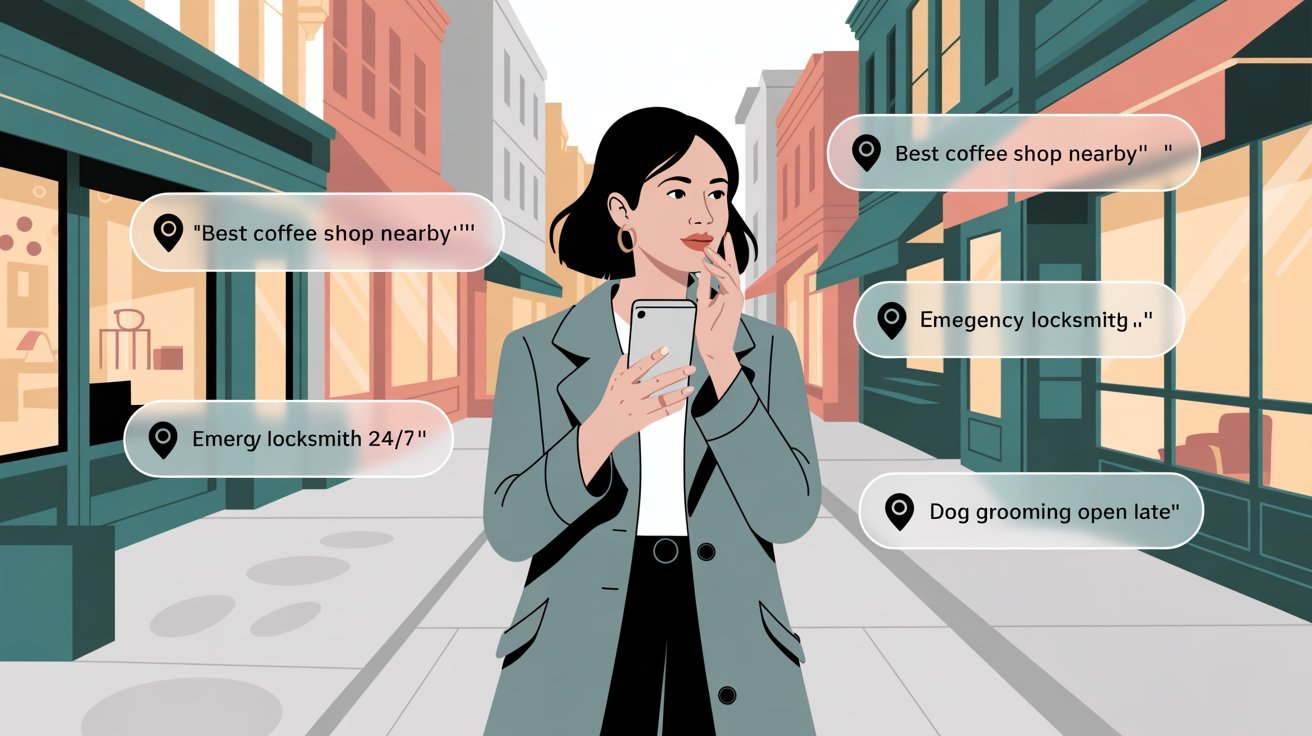
Why Voice Search Matters for Local Businesses?
Voice search has moved into the daily routine. People speak to assistants on their phones, on the dashboard, and in the living room to find nearby shops and services. Think of real moments: “latte near me” on the morning drive, “emergency plumber open now” when the pipe bursts at night, or “closest nail bar” before a last-minute plan. Those spoken requests often decide who gets found first.
If you run a local business, giving voice search SEO attention in 2025 is about being present at the exact moment customers ask aloud—hands free, on the go, and ready to act.
How Voice Search SEO Works (and Why It’s Different)?
People speak in full thoughts, not shorthand. Voice queries are longer, more conversational, and usually framed as questions.
Example: Instead of typing “pizza restaurant Chicago,” someone says, “Where can I get proper deep-dish pizza near me?”
You’ll hear intent words like “find,” “buy,” “open now,” plus location hints such as “near me,” neighborhoods, and city names.
To earn these visits, build pages that respond like a person would—not pages that simply pile up keywords.
Tip: Target longer, question-style phrases and shape copy so it delivers a direct, natural answer right away. Clear, answer-first sections are more likely to be surfaced by assistants.
Local SEO Foundations for Voice Search
Before advanced tactics, lock in the basics. Voice assistants lean heavily on your Google Business Profile (GBP), citations, and on-site details.
Optimize Your Google Business Profile
- Claim and verify your listing. Keep your name, address, and phone (NAP) identical everywhere.
- Pick precise categories, maintain accurate hours (including holidays), and refresh photos frequently.
- Reply to reviews and Q&A in everyday language—those lines can show up in spoken results.
Pro Tip: Echo your customers. If reviews mention “quick service” or “best fish tacos,” those phrases often mirror how people phrase their voice requests.
Implement Local Schema Markup
Help search engines understand your business details at a glance.
- Add LocalBusiness and FAQ schema using JSON-LD.
- Validate with Google’s Rich Results testing tools.
- Keep data synced with what’s on your GBP and contact pages.
Clean, consistent structured data improves eligibility for rich results and gives assistants concise facts to read aloud.
Optimize for “Near Me” and Geo-Targeted Searches
- Work neighborhood names, landmarks, and ZIP codes naturally into copy.
- Create location or service-area pages with unique details, directions, parking tips, and localized reviews.
- Test phrases like “near me” in Google’s People Also Ask section for content inspiration.
Crafting Voice-Friendly Content
Great voice content sounds like a helpful human: brief, specific, and easy to understand.
Use a Conversational Tone
Write like you’re on the phone with a customer—short sentences, common words, and contractions (“you’re,” “we’ll”).
- Add question-style subheads such as “How do I book an appointment?”
- Read your copy aloud; if it sounds stiff, simplify it.
- Tools like Grammarly can help make content more natural and user-friendly.
Create FAQ Pages and Short Answers
Assistants prefer compact, direct responses.
- Build an FAQ that tackles hours, pricing cues, insurance/guarantees, parking, service areas, and timing.
- Keep answers tight (around two sentences) when possible.
Example:
Question: “How late is Marco’s Pizza open?”
Answer: “Marco’s Pizza is open until 11 PM daily. Delivery runs until 10 PM.”
These punchy blocks are prime candidates for the short summaries assistants read aloud.
Aim for Featured Snippets
Featured Snippets, also called position zero, dominate voice search results.
- Present steps, definitions, and lists with bullets or numbers.
- Put the direct “what,” “how,” or “where” answer first; add context below.
- Capture common questions from customer emails, chats, and calls—not only from SEO tools.
Technical SEO and Mobile Optimization
Because most voice lookups happen on phones or smart devices, speed and stability matter.
- Keep pages snappy—ideally under three seconds to first meaningful interaction.
- Meet Core Web Vitals, including INP (Interaction to Next Paint) for interactivity, and keep layout shifts minimal.
- Use HTTPS, logical internal links, tidy sitemaps, and pared-down scripts to help crawlers and users alike.
Bonus: High-volume publishers and blogs can still consider AMP (Accelerated Mobile Pages) for certain mobile contexts where speed is critical.
Leverage Reviews and Social Proof
Reviews influence trust and which options surface first locally.
- Ask happy customers for detailed, natural reviews that mention products, neighborhoods, or staff by name.
- Respond quickly and courteously; your tone becomes part of your brand.
- Highlight select quotes on location pages and support them with Review schema to reinforce credibility.
Assistants and map results often use review language as shorthand for reputation—make that language work for you.
Measure and Improve Voice Search Performance
You can’t see a single “voice” metric everywhere, but you can watch the right signals.
- In Google Search Console, track growth in question phrases and longer queries.
- Use local rank/visibility tools to monitor map packs and finder results around your service areas.
- Watch analytics for mobile visits, direction requests, tap-to-call events, and “near me” patterns.
Tip: Review your plan every quarter. SERP features change, assistants evolve, and small technical fixes (like improving INP or tightening internal links) can move the needle.
The Future of Voice Search for Local Businesses
Voice is spreading to more moments—cars, wearables, storefront kiosks, and smart home screens. Some customers will complete the entire path through voice alone: discovery, quick questions, booking, reminders, and updates. Local brands that build conversational touchpoints—voice-enabled scheduling, order status, or post-service follow-ups—will feel native to how people search.
In short, voice optimization is not a one-and-done checklist. It’s an ongoing habit that mirrors how people naturally talk.
FAQs: Voice Search SEO for Local Businesses
Results tend to favor nearby, well-reviewed businesses with clear categories, consistent NAP, and pages that answer questions directly.
Give concise answers to common questions, mark them up with FAQ and LocalBusiness schema, and format for a clean summary at the top of the page.
Yes. Hyperlocal pages, accurate categories, strong reviews, and fast mobile performance can beat bigger competitors in your immediate area.
Voice queries are longer and intent-heavy. You’ll target full questions, use natural language, and present the answer upfront.
Restaurants, home services, medical/dental, and retail often benefit most—especially for time-sensitive prompts like “open now” or location-based “near me.”
Key Takeaway
Voice search is reshaping the local discovery moment. Optimize your Google Business Profile, write answer-first content in natural language, and keep your site fast and stable. Do those three consistently, and you put your business in the path of customers who are literally asking for you.
At RevoluteX Digital, we help neighborhood businesses stay visible with voice-ready content, clean technical foundations, and review strategies that compound over time. Our team makes sure your brand is heard—by the right people, in the right moments. Contact us today!
Jason
We are an Affordable Digital Marketing Agency in Shawnee with budget-friendly solutions to amplify your brand. Elevate your business without compromising quality or cost.
